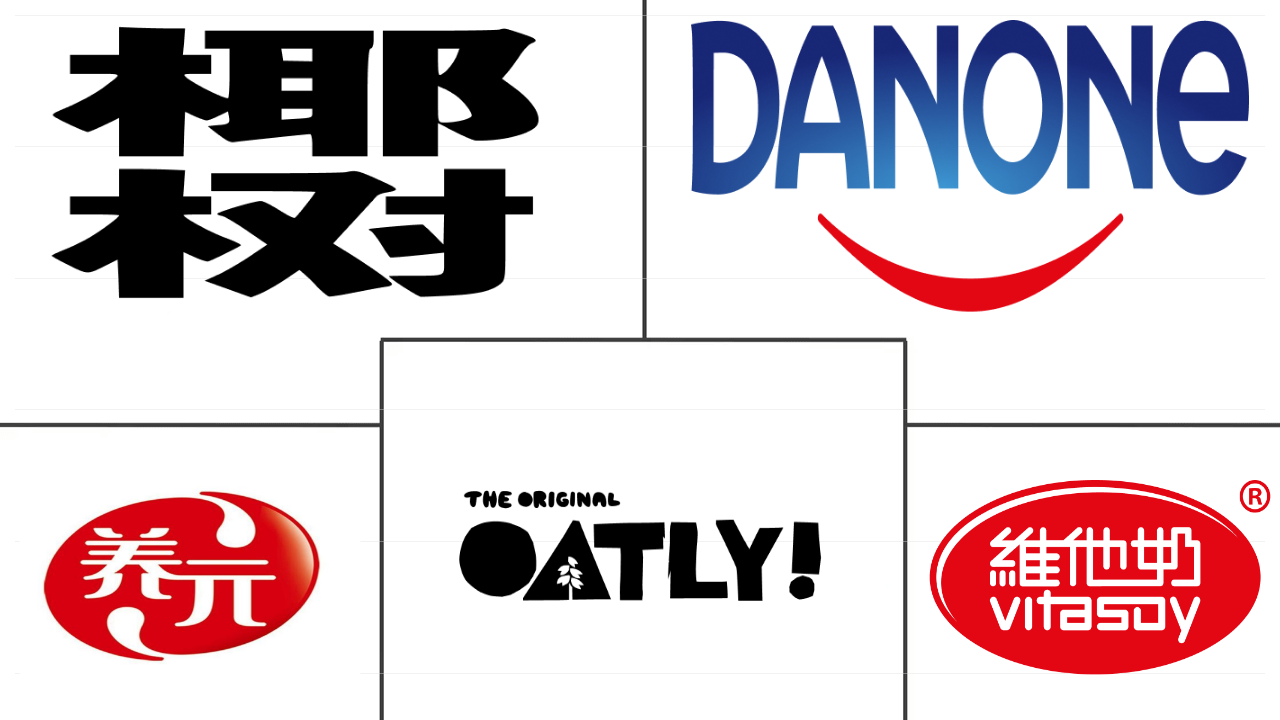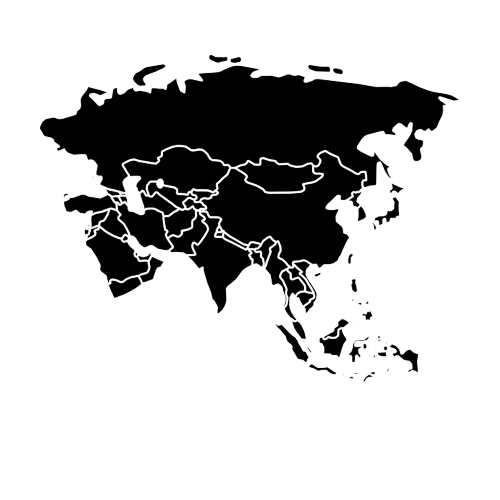Market Size of non-dairy milk Industry
|
|
Study Period | 2017 - 2029 |
|
|
Market Size (2024) | USD 21.19 Billion |
|
|
Market Size (2029) | USD 35.88 Billion |
|
|
Largest Share by Distribution Channel | Off-Trade |
|
|
CAGR (2024 - 2029) | 11.11 % |
|
|
Largest Share by Region | Asia-Pacific |
|
|
Market Concentration | Low |
Major Players |
||

|
||
|
*Disclaimer: Major Players sorted in no particular order |
Non-Dairy Milk Market Analysis
The Non-Dairy Milk Market size is estimated at 21.19 billion USD in 2024, and is expected to reach 35.88 billion USD by 2029, growing at a CAGR of 11.11% during the forecast period (2024-2029).
21.19 Billion
Market Size in 2024 (USD)
35.88 Billion
Market Size in 2029 (USD)
8.30 %
CAGR (2017-2023)
11.11 %
CAGR (2024-2029)
Largest Market by Distribution Channel
93.68 %
value share, Off-Trade, 2023
The product assortment and shelf space in off-trade retail channels is allowing consumers to compare the products, which has emerged to be one of the major factor driving segmental growth.
Largest Market by Region
45.81 %
value share, Asia-Pacific, 2023

The availability of an abundance of raw materials for plant-based milk and an agriculture production base to produce plant-based sources is fuelling the growth of the Asia-Pacific region.
Fastest-growing Market by Distribution Channel
11.32 %
Projected CAGR, Off-Trade, 2024-2029
The ongoing demand in off-trade channels majorly through online distribution channel as it provides ease of shopping with ample option availability is inticing the growth of segment.
Fastest-growing Market by Region
19.95 %
Projected CAGR, Middle East, 2024-2029
The shift in consumer behavior is largely driving the Middle East region. It was majorly due to the rising concerns regarding animal welfare, personal health, and sustainability.
Leading Market Player
12.66 %
market share, Danone SA, 2022

Danone S.A's major focus on the quality and high standards of the products in plant-based beverages segment with produts in wider range of brands made it maket leader
Growing expansion by leading retail chains resulting in higher sales through these channels.
- Global off-trade retailing dominated the overall retail space during the review period (2017-2022). In 2022, it was observed that consumer satisfaction was the major factor associated with these retailers. Consumers are highly fascinated by off-trade retailing due to the greater convenience and comfort they get during purchasing plant-based milk. In 2022, the global distribution channel for plant-based milk observed a growth of 6.84% from 2021.
- By region, Asia-Pacific is marked as the largest region, which holds a share of 48.73% in the overall off-trade distribution channels. In the Asia-Pacific region, off-trade channels offer plant-based milk at varied prices (low, medium, and high). Oat milk was sold at an average price of USD 2.55 in 2022. The availability of plant-based milk at varied prices also promotes the buying power among consumers as they can purchase the products that suit their affordability parameters.
- On-trade retailers are focusing on providing a variety of plant-based milk, including different flavors, such as unsweetened, chocolate, and vanilla. Despite offering different flavors, these retailers cannot provide complete information such as product specifics (ingredient used, seed used, and others) to consumers. As a result, consumers purchase plant-based milk beverages through off-trade modes. In 2022, Europe was considered the fastest-growing region for on-trade channels as they held a share of 7.41%.
- Between 2018 and 2022, under the off-trade mode, specialty stores gained significant demand as they offered higher visibility about the product to consumers. Considering the rising demand for plant-based milk, global distribution is expected to grow by 24.7% in 2025 from 2022.
With a larger per capita consumption of non-dairy milk, Asia-Pacific leads the market, followed by Europe, with the two regions occupying 75% of volume share globally
- The global plant-based milk industry witnessed a growth of 2.83% in 2022 compared to 2021, driven by the increasing number of health-conscious consumers worldwide. In 2022, the per capita consumption of plant-based milk reached 1.28 kg. Popular brands in the plant-based milk market include Oatly, Minor Figures, Alpro, and Califia Farms.
- In Asia-Pacific, plant-based milk has wide usage for various purposes. In 2022, oat milk emerged as the preferred substitute for animal-based milk among consumers in this region. Australia, in particular, experienced significant growth in the plant-based milk sector. With 30% of the population diagnosed with irritable bowel syndrome (IBS) in 2022, oat milk, known for its soluble fiber content, became sought after as it offers relief for IBS and constipation.
- In North America, plant-based milk is consumed as a healthy beverage by a significant portion of the population, particularly health-conscious individuals. Oat milk, with its lower fat content compared to animal-based milk, is favored by those following calorie deficit plans. Additionally, oat milk is a lactose-free alternative for individuals with lactose intolerance. The per capita consumption of non-dairy milk in this region was 3.23 kg in 2022.
- During the forecast period, it is estimated that the demand for plant-based milk will continue to rise by 5.78% due to increasing awareness of its benefits. Furthermore, consumers are expected to show a preference for innovative flavors in the plant-based milk segment.
Non-Dairy Milk Industry Segmentation
Almond Milk, Cashew Milk, Coconut Milk, Hazelnut Milk, Hemp Milk, Oat Milk, Soy Milk are covered as segments by Product Type. Off-Trade, On-Trade are covered as segments by Distribution Channel. Africa, Asia-Pacific, Europe, Middle East, North America, South America are covered as segments by Region.
- Global off-trade retailing dominated the overall retail space during the review period (2017-2022). In 2022, it was observed that consumer satisfaction was the major factor associated with these retailers. Consumers are highly fascinated by off-trade retailing due to the greater convenience and comfort they get during purchasing plant-based milk. In 2022, the global distribution channel for plant-based milk observed a growth of 6.84% from 2021.
- By region, Asia-Pacific is marked as the largest region, which holds a share of 48.73% in the overall off-trade distribution channels. In the Asia-Pacific region, off-trade channels offer plant-based milk at varied prices (low, medium, and high). Oat milk was sold at an average price of USD 2.55 in 2022. The availability of plant-based milk at varied prices also promotes the buying power among consumers as they can purchase the products that suit their affordability parameters.
- On-trade retailers are focusing on providing a variety of plant-based milk, including different flavors, such as unsweetened, chocolate, and vanilla. Despite offering different flavors, these retailers cannot provide complete information such as product specifics (ingredient used, seed used, and others) to consumers. As a result, consumers purchase plant-based milk beverages through off-trade modes. In 2022, Europe was considered the fastest-growing region for on-trade channels as they held a share of 7.41%.
- Between 2018 and 2022, under the off-trade mode, specialty stores gained significant demand as they offered higher visibility about the product to consumers. Considering the rising demand for plant-based milk, global distribution is expected to grow by 24.7% in 2025 from 2022.
| Product Type | |
| Almond Milk | |
| Cashew Milk | |
| Coconut Milk | |
| Hazelnut Milk | |
| Hemp Milk | |
| Oat Milk | |
| Soy Milk |
| Distribution Channel | |||||||
| |||||||
| On-Trade |
| Region | ||||||||||||||
| ||||||||||||||
| ||||||||||||||
| ||||||||||||||
| ||||||||||||||
| ||||||||||||||
|
Non-Dairy Milk Market Size Summary
The non-dairy milk market is experiencing significant growth, driven by increasing consumer awareness of health benefits and dietary preferences. This market is characterized by a diverse range of plant-based milk options, including soy, almond, and oat milk, which are gaining popularity as alternatives to traditional dairy products. The demand for these products is fueled by factors such as lactose intolerance, milk allergies, and a growing preference for sustainable and healthy food choices. The market is fragmented, with key players like Coconut Palm Group Co. Ltd, Danone SA, Hebei Yangyuan Zhihui Beverage Co. Ltd, Oatly Group AB, and Vitasoy International Holdings Ltd leading the charge. These companies are continuously innovating and expanding their product offerings to cater to the evolving consumer preferences for flavors and nutritional content.
Regionally, Asia-Pacific stands out as the largest market for non-dairy milk, with a significant share in off-trade distribution channels. The availability of plant-based milk at various price points in this region enhances consumer accessibility and purchasing power. In North America, non-dairy milk is increasingly consumed by health-conscious individuals, particularly those following calorie deficit plans or seeking lactose-free alternatives. The European market is also witnessing a rise in the consumption of plant-based milk, with a notable shift towards these alternatives among a broader consumer base, not just vegans and vegetarians. The market's growth trajectory is supported by the rising demand for innovative flavors and the increasing prevalence of health-conscious consumers worldwide.
Non-Dairy Milk Market Size - Table of Contents
-
1. MARKET SEGMENTATION (includes market size in Value in USD and Volume, Forecasts up to 2030 and analysis of growth prospects)
-
1.1 Product Type
-
1.1.1 Almond Milk
-
1.1.2 Cashew Milk
-
1.1.3 Coconut Milk
-
1.1.4 Hazelnut Milk
-
1.1.5 Hemp Milk
-
1.1.6 Oat Milk
-
1.1.7 Soy Milk
-
-
1.2 Distribution Channel
-
1.2.1 Off-Trade
-
1.2.1.1 Convenience Stores
-
1.2.1.2 Online Retail
-
1.2.1.3 Specialist Retailers
-
1.2.1.4 Supermarkets and Hypermarkets
-
1.2.1.5 Others (Warehouse clubs, gas stations, etc.)
-
-
1.2.2 On-Trade
-
-
1.3 Region
-
1.3.1 Africa
-
1.3.1.1 By Product Type
-
1.3.1.2 By Distribution Channel
-
1.3.1.3 Egypt
-
1.3.1.4 Nigeria
-
1.3.1.5 South Africa
-
1.3.1.6 Rest of Africa
-
-
1.3.2 Asia-Pacific
-
1.3.2.1 By Product Type
-
1.3.2.2 By Distribution Channel
-
1.3.2.3 Australia
-
1.3.2.4 China
-
1.3.2.5 India
-
1.3.2.6 Indonesia
-
1.3.2.7 Japan
-
1.3.2.8 Malaysia
-
1.3.2.9 New Zealand
-
1.3.2.10 Pakistan
-
1.3.2.11 South Korea
-
1.3.2.12 Rest of Asia Pacific
-
-
1.3.3 Europe
-
1.3.3.1 By Product Type
-
1.3.3.2 By Distribution Channel
-
1.3.3.3 Belgium
-
1.3.3.4 France
-
1.3.3.5 Germany
-
1.3.3.6 Italy
-
1.3.3.7 Netherlands
-
1.3.3.8 Russia
-
1.3.3.9 Spain
-
1.3.3.10 Turkey
-
1.3.3.11 United Kingdom
-
1.3.3.12 Rest of Europe
-
-
1.3.4 Middle East
-
1.3.4.1 By Product Type
-
1.3.4.2 By Distribution Channel
-
1.3.4.3 Bahrain
-
1.3.4.4 Kuwait
-
1.3.4.5 Oman
-
1.3.4.6 Qatar
-
1.3.4.7 Saudi Arabia
-
1.3.4.8 United Arab Emirates
-
1.3.4.9 Rest of Middle East
-
-
1.3.5 North America
-
1.3.5.1 By Product Type
-
1.3.5.2 By Distribution Channel
-
1.3.5.3 Canada
-
1.3.5.4 Mexico
-
1.3.5.5 United States
-
1.3.5.6 Rest of North America
-
-
1.3.6 South America
-
1.3.6.1 By Product Type
-
1.3.6.2 By Distribution Channel
-
1.3.6.3 Argentina
-
1.3.6.4 Brazil
-
1.3.6.5 Rest of South America
-
-
-
Non-Dairy Milk Market Size FAQs
How big is the Global Non-Dairy Milk Market?
The Global Non-Dairy Milk Market size is expected to reach USD 23.37 billion in 2025 and grow at a CAGR of 11.57% to reach USD 40.39 billion by 2030.
What is the current Global Non-Dairy Milk Market size?
In 2025, the Global Non-Dairy Milk Market size is expected to reach USD 23.37 billion.

